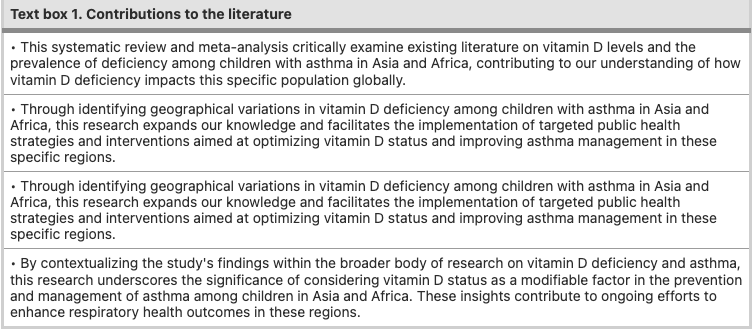
Chanie, E.S., Zhang, G. & Le Souef, P. . Arch Public Health 82, 103 (2024). https://doi.org/10.1186/s13690-024-01321-5
Abstract
Background
Several studies on the serum level of vitamin D and the percentage of vitamin D deficiency in children with asthma have been conducted in Asia and Africa, but the results have been inconsistent and inconclusive, requiring a systematic review and meta-analysis to assess the strength of the evidence.
Objective
The objective of this review is to synthesize evidence on serum levels of vitamin D and the percentage of vitamin D deficiency among children with asthma in Asia and Africa.
Methods
To identify relevant articles, a comprehensive search was conducted across various databases and repositories such as PubMed, Google Scholar, Hinary, Web of Science, ResearchGate, as well as gray literature sources. The Preferred Reporting Items for Systematic Review and Meta-Analysis (PRISMA) guidelines were followed during the retrieval process. Data extraction was performed following a standardized format based on the JBI (Joanna Briggs Institute) data extraction guidelines. Microsoft Excel was utilized for data extraction, and subsequently, the data was exported to STATA 17 for further analysis. To assess the heterogeneity among the included studies, Cochrane Q-statistics and the I2 tests were employed. Publication bias was assessed using the Egger test and funnel plot.
Result
This meta-analysis investigated 33 articles encompassing a total of 3432 children diagnosed with asthma. The findings demonstrated that in low- or middle-income countries across Africa and Asia, children with asthma had an average serum vitamin D level of 21.9 ng/ml (95% confidence interval [CI]: 18.0–25.9 ng/ml), with 53.7% (95% CI: 40.5–66.9) experiencing vitamin D deficiency. Additionally, when considering the continent, children with asthma in Asia had an average serum vitamin D level of 18.5 ng/ml (95% CI: 13.8–23.3), while those in Africa had a level of 28.7 ng/ml (95% CI: 22.7–34.8). The analysis further explored different sub-group analyses. Depending on the study design, case–control studies yielded an average serum vitamin D level of 20.3 ng/ml (95% CI: 18.2–22.4), whereas cross-sectional studies resulted in 23.8 ng/ml (95% CI: 17.5–30.1). Based on publication year, studies published on or before 2015 had an average serum level of 21.0 ng/ml (95% CI: 18.0–24.0), while those published after 2015 had a level of 22.4 ng/ml (95% CI: 17.2–27.7). Moreover, when considering sample size, studies with 100 participants or less had an average serum level of 21.7 ng/ml (95% CI: 17.3–26.1), while studies with more than 100 participants had a level of 22.1 ng/ml (95% CI: 18.6–25.6).
Conclusion
Children with asthma in Asia and Africa were found to have low serum levels of vitamin D and a high percentage of vitamin D deficiency. This highlights the importance of early detection and monitoring of vitamin D levels in these children to prevent potential complications associated with vitamin D deficiency. Taking proactive measures to address and manage vitamin D deficiency is crucial for the well-being of children with asthma in these regions.

